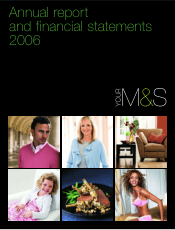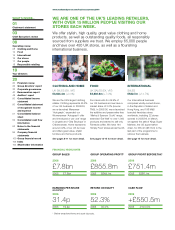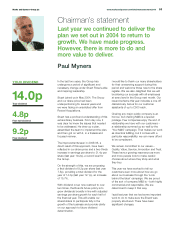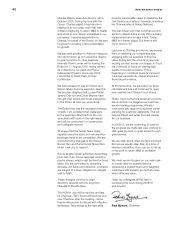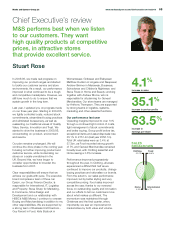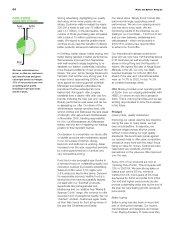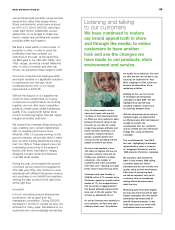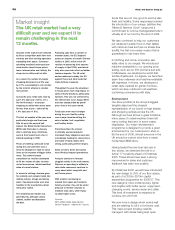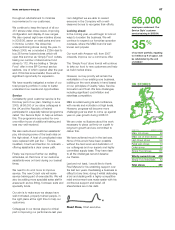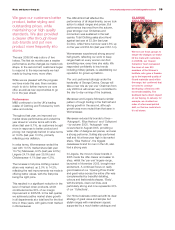Marks and Spencer 2006 Annual Report Download - page 11
Download and view the complete annual report
Please find page 11 of the 2006 Marks and Spencer annual report below. You can navigate through the pages in the report by either clicking on the pages listed below, or by using the keyword search tool below to find specific information within the annual report.
Marks and Spencer Group plc
We gave our customers better
product, better styling and
outstanding prices, while
maintaining our high quality
standards. We also provided
a clearer offer through fewer
sub-brands and put new
product more frequently into
stores.
The year 2005/06 was a story of two
halves. The first six months saw a weaker
performance as the changes we made took
shape. In the second half, customers began
to respond to the improvements we had
made by buying more, more often.
While we are pleased with the progress
we have made this year, there remains
much to do to further improve our core
offer, as well as new opportunities to go
for in the year ahead.
Performance
M&S continues to be the UK’s leading
retailer of Clothing and Footwear by both
value and volume.
Throughout last year, we improved our
market share performance and ended the
year ahead in volume terms with 9.9%
share (last year 9.7%), as customers bought
more in response to better product and
pricing; but marginally behind in value terms
at 10.2% (last year 10.5%), primarily
reflecting price deflation.
In value terms, Womenswear ended the
year with 10.5% market share (last year
10.7%); Menswear, 9.5% (last year 9.8%);
Lingerie 24.1% (last year 25.5%) and
Childrenswear 4.1% (last year 4.3%).
The increase in full price clothing market
share was marked, up 2.0% to 14.2%,
reflecting the real improvements we made in
offering better values, with the first price
being the right price.
This resulted in a significant reduction in the
level of marked down products, which
contributed some 50% of our margin
improvement in 2005/06. In the last quarter,
we achieved positive market share growth
in all departments at a total level for the first
time in three years, with gains most marked
in Womenswear.
The difficult first half affected the
performance of all departments, as we took
action to adjust ranges and prices. But
performance improved from the autumn,
grew stronger over Christmas and
momentum was sustained in the last
quarter. Total Clothing sales stood level
against last year at £3.3bn (last year
£3.3bn), while Home turnover was 0.8% up
on the year at £353.8m (last year £351.1m).
Womenswear experienced strong second
half growth, reflecting our work to keep
ranges fresh so every woman can find
something new, every time she visits. We
responded confidently to key trends
including military jackets, re-establishing our
reputation for grown-up fashion.
‘Per una’ performed strongly under the
leadership of George Davies. George will
take a new role as ‘per una’ Chairman from
July 2006 but will remain very committed to
the day-to-day running of the business.
Menswear and Lingerie followed a similar
pattern of tough trading in the first half and
strong growth in the second, although
growth was more muted than that seen in
Womenswear.
Menswear reduced its brands to three –
‘Autograph’, ‘Blue Harbour’ and ‘Collezione’
– by autumn 2005. ‘Autograph’ was
re-launched in August 2005, providing a
wider offer of designer-led pieces, and was
a strong performer. Suiting also performed
well and hit a three-year high in its market
share. ‘Blue Harbour’, the biggest
casualwear brand for men in the UK, also
had a strong year.
In Lingerie, the move to fewer brands in
2005 made the offer clearer and easier to
shop, whilst the ‘per una’ lingerie range,
launched in November 2005, brought new
excitement. A continued focus on really
good basics at our ‘Opening Price Points’
and great value across the entire offer was
complemented by beautiful detailing,
colours and fashionable shapes. ‘Body’,
with its simple, clean-cut lines, was
particularly strong and now represents 30%
of our ‘Collections’.
Our Home business continued with its clear
strategy of great value and simpler but
stylish ranges with mainstream appeal,
supported by a much better catalogue and
CLASSIC
COLLECTION
We now use focus groups to
ensure the changes we make
hit the mark with customers.
In 2005/06, our ‘Classic
Collection’ team canvassed
the views of over 800
members of the Women’s
Institute, who gave a thumbs-
up to the improved quality of
fit and materials used within
the range, but confirmed that
we need to continue
developing collections with
more fashionability. The
feedback had a direct impact
on our buying. In January, for
example, we doubled our
order of a favoured printed
skirt, so that we could stock
it in all stores.
www.marksandspencer.com/clothingandhome2006 09

